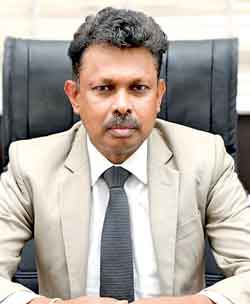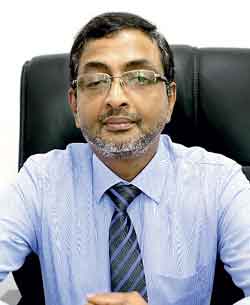Thursday Jan 08, 2026
Thursday Jan 08, 2026
Thursday, 26 June 2025 15:07 - - {{hitsCtrl.values.hits}}
By Safrah Fazal
Transitioning to a sustainable energy driven economy with increased share of renewable energy in energy supply and enhancing energy efficiency has never been more crucial for Sri Lanka, especially in light of escalating unrest in the Middle East and its global repercussions.
Today (June 26), in recognition of National Energy Day, DailyFT spoke with Sri Lanka Sustainable Energy Authority (SLSEA) Chairman Prof. Wijendra Bandara and Director General Harsha Wickramasinghe to discuss the country’s ongoing efforts to shift towards renewable energy and greater energy efficiency.
“This year’s National Energy Day carries a powerful and timely message: ‘Our Power, Our Planet.’ It’s especially relevant now, as Sri Lanka faces a critical juncture in its energy landscape—economically, environmentally, and operationally. The 2022 economic crisis severely hampered the country’s ability to import fossil fuels, resulting in significant shortages. Transitioning to renewable energy and improving efficiency is essential not only to reduce dependence on foreign exchange but also to shield Sri Lanka from global fuel price shocks. For instance, the ongoing conflict in the Middle East can drastically impact international fuel prices,” Prof. Bandara said.
Renewable energy target of 70% by 2030
 |
| Prof. Wijendra Bandara Chairman of Sri Lanka Sustainable Energy Authority (SLSEA) |
Wickramasinghe noted that achieving carbon neutrality by 2050 is not a major challenge for Sri Lanka. “We have a significant carbon sink thanks to our extensive home gardens and forest cover, so our net carbon emissions are relatively manageable compared to larger economies like India and China. We can definitely become carbon neutral by 2050,” he emphasised.
However, he acknowledged that reaching the target of 70% renewable energy by 2030 presents a more difficult challenge. “By 2024, we reached about 55% renewable energy in electricity generation, aided by favourable rainfall and other factors. But maintaining that 55% and adding an additional 15% over the next five years is going to be tough. With determined effort and a realistic means to finance this effort, especially with external funding, it’s possible, but there’s a lot that needs to be done,” Wickramasinghe explained.
Meanwhile, Prof. Bandara highlighted that the SLSEA has a clearly defined strategic mission aligned with the national goal of achieving 70% renewable energy by 2030, including installing over 2,000 MW of solar capacity before that deadline.
“One of our priorities is to promote the renewable energy share in the country. We identify, assess, and develop indigenous renewable sources, such as solar, wind, biomass, and hydro, to enhance energy security and generate economic benefits. Another key focus is improving energy efficiency and conservation across all sectors like
 |
| Eng. Harsha Wickramasinghe Director General of Sri Lanka Sustainable Energy Authority (SLSEA) |
industrial, transport, commercial, and domestic through initiatives like appliance energy labeling, energy benchmarking, energy-efficient building codes, and energy audits. In addition, we place strong emphasis on energy awareness and capacity building,” he said.
Prof. Bandara also pointed to SLSEA’s significant progress in recent years, including the facilitation of over 1,700 MW in solar rooftop systems, and both off-grid and on-grid renewable energy projects. The SLSEA has introduced appliance energy labeling to encourage the use of energy-efficient products, enforced energy benchmarking regulations to improve efficiency in the commercial and industrial sectors, and launched pilot projects for energy conservation.
“One such project is the implementation of efficient and disease-resilient air conditioning systems at three public buildings, supported by financial assistance from the Asian Development Bank (ADB),” he noted.
“Aligned with global climate goals such as carbon neutrality by 2050, we are committed to accelerating the energy transition through cleaner energy sources. Renewable energy investments are also fostering local entrepreneurship — for instance, in rooftop solar installations — contributing to economic recovery. Together with the Government and Ministry of Energy, we are now fast-tracking infrastructure development,” he added.
Off-grid solar panels in rural villages
As part of its efforts to expand access to renewable energy, the SLSEA recently supported the installation of off-grid solar photovoltaic systems (PV) in remote villages. According to Prof. Bandara, one such initiative provided lighting and water-pumping systems to schools in the village of Galamuduna in the Kandy District.
He also highlighted the Three-Island Hybrid Renewable Energy Project, a major undertaking led by SLSEA to deliver clean and reliable electricity to the remote islands of Delft, Nainativu, and Analaitivu in the Jaffna District, which are not connected to the national grid. Funded by a grant from the Government of India, the project integrates 1,700 kW of solar PV, 530 kW of wind power, 2,400 kWh of battery storage, and 2,500 kW of backup diesel generation on each island.
Incentivising wider adoption of renewable energy, Prof. Bandara explained that SLSEA offers a variety of support schemes for households and businesses, particularly to encourage the use of solar power. “Through our programmes, users can benefit from net-metering, net-accounting, or net-plus schemes, which allow them to reduce electricity costs or sell excess solar energy back to the grid at favourable rates. We’ve also introduced feed-in tariffs for projects under 10 MW, and offer tax waivers for projects over 1 MW to encourage developers,” he said.
Most recently, SLSEA partnered with the Clean Sri Lanka Programme to promote and develop clean energy integration into the national grid.
Can the national grid support more solar panels?
According to Prof. Bandara, Sri Lanka’s national grid has the potential to support increased solar power adoption, but its current limitations in capacity and flexibility restrict the integration of large-scale renewable energy sources such as solar and wind. Significant upgrades are needed to maintain grid stability and reliability.
“While the country has strong solar potential and ambitious renewable energy targets, key challenges remain — particularly the need to improve grid infrastructure, implement energy storage solutions, and introduce real-time grid management to handle the intermittent nature of solar power,” he explained.
“Without adequate investment in technologies like battery storage, smart grid systems, and the installation of smart meters, high solar penetration could cause voltage fluctuations and operational issues. Although progress is underway, a coordinated effort involving utilities, policymakers, and private investors is essential to ensure the grid can sustainably accommodate the growing demand for solar energy across the country,” said Prof. Bandara.
“This year’s National Energy Day carries a powerful and timely message: ‘Our Power, Our Planet.’ It’s especially relevant now, as Sri Lanka faces a critical juncture in its energy landscape—economically, environmentally, and operationally. The 2022 economic crisis severely hampered the country’s ability to import fossil fuels, resulting in significant shortages. Transitioning to renewable energy and improving efficiency is essential not only to reduce dependence on foreign exchange but also to shield Sri Lanka from global fuel price shocks. For instance, the ongoing conflict in the Middle East can drastically impact international fuel prices,” Prof. Bandara said
More challenges
Prof. Bandara highlighted that financial constraints, worsened by the recent economic crisis, have significantly reduced public funding and made it more difficult to attract private investment. “We are currently working with the Ceylon Electricity Board to revise our five-year plan with more realistic and achievable goals,” he said.
He also pointed out that delays in regulatory approvals and inconsistent policy implementation create uncertainty for developers, further hindering progress. “There is also limited public awareness and lack of behavioural change, which makes it harder to promote widespread adoption of energy-efficient practices. Addressing these interconnected challenges is essential if Sri Lanka is to meet its renewable energy and climate targets. We are now taking mitigating actions,” he added.
Another concern is the shortage of skilled professionals in critical areas such as energy auditing, renewable energy installation, and grid management. This is despite the SLSEA actively promoting solar energy education and workforce development. “In collaboration with the Public Utilities Commission of Sri Lanka (PUCSL) and the National Apprentice and Industrial Training Authority (NAITA), SLSEA offers the National Solar Technician Program, which provides NVQ Level 3 certification. Over 1,000 technicians have already been trained across the country,” Prof. Bandara said.
Meanwhile, Wickramasinghe emphasised that renewable energy, energy efficiency, and sustainable energy, including electric mobility, represent a new and growing set of skills in the labour market. He urged young people and school leavers to pursue training in these fields, saying: “Those who embrace these technologies will never be out of work if they prepare themselves for a sustainable energy future,” he said.
“We’re working closely with tertiary education institutions to train technicians. But to tell you the truth, once they gain some work experience, many of them migrate because they find lucrative opportunities abroad,” he added.
The collapsing fossil fuel industry
Wickramasinghe spoke about the ongoing global energy transition, pointing out that the fossil fuel industry is gradually giving way to sustainable energy.
“Energy transition is a global trend, a phenomenon where entrenched sectors like the oil industry are being dismantled before our eyes. Their funding streams and engineering efforts are drying up, showing telltale signs of an industry with limited growth prospects. When an industry begins to fall, there are early indicators, such as investors withdrawing capital and redirecting it toward competing sectors,” he explained.
Wickramasinghe noted that this shift has been visible for over a decade in developed markets. “Even in Sri Lanka, we see our banking sector eager to invest in green energy. Previously, they were focused on lucrative fossil fuel-based power plants. Today, their focus has shifted toward renewable projects like wind and solar. These are clear signs of the fossil fuel industry reaching its peak, and a growing vigour emerging in the renewable energy sector,” he remarked.
While acknowledging that Sri Lanka is still in the early stages of this transition, he emphasised that the SLSEA is taking the lead in steering the country toward a sustainable energy future. He also stressed that public participation is crucial in making this transition successful.
Projects in the pipeline
The SLSEA is expanding its focus into the irrigation sector by implementing solar-powered water pumping systems. Two off-grid electrification projects are also set to energize remote villages in the Central Province in the near future.
Currently, the SLSEA is facilitating a 10 MW ground-mounted solar project spearheaded by the Ministry of Buddhasasana, Religious and Cultural Affairs. Additionally, a large-scale solar rooftop initiative aims to install 5 kW systems in 5,000 religious institutions across the country.
Several large-scale renewable energy projects are also in the pipeline, with the following expected commissioning timelines:
Sustainability summit on National Energy Day
Meanwhile, on this day, the SLSEA is partnering with Commercial Bank to host a sustainability summit with the theme: Forward Together. “This summit will bring together an exclusive audience from the government and private sectors, international organisations, academia, and sustainability experts. It offers a unique platform to share insights and build partnerships aimed at finding solutions for the future,” Prof. Bandara explained.